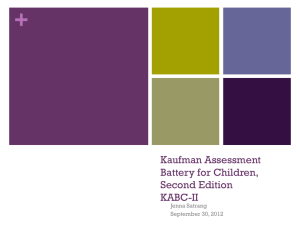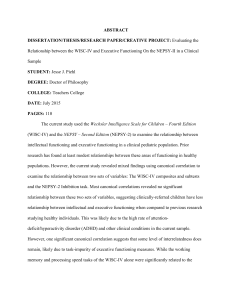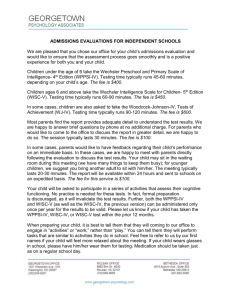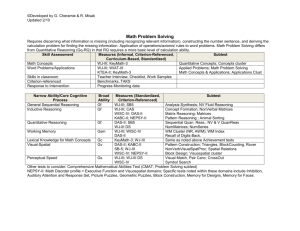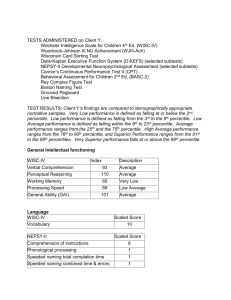Kaufman Assessment Battery for Children, Second Edition
advertisement
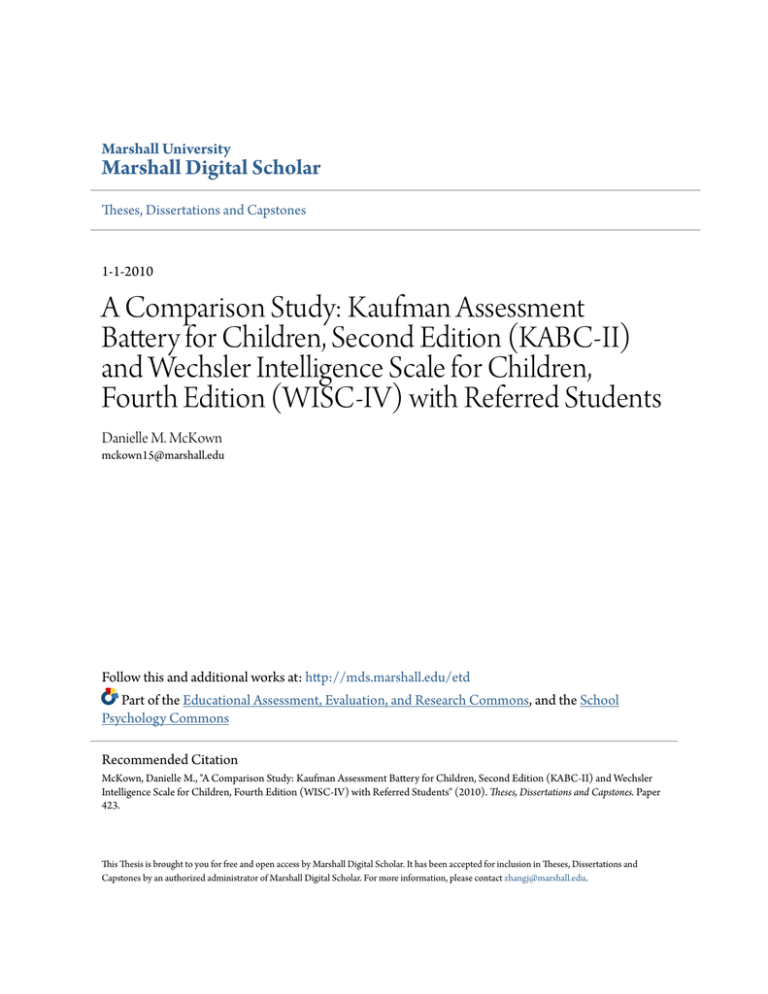
Marshall University Marshall Digital Scholar Theses, Dissertations and Capstones 1-1-2010 A Comparison Study: Kaufman Assessment Battery for Children, Second Edition (KABC-II) and Wechsler Intelligence Scale for Children, Fourth Edition (WISC-IV) with Referred Students Danielle M. McKown mckown15@marshall.edu Follow this and additional works at: http://mds.marshall.edu/etd Part of the Educational Assessment, Evaluation, and Research Commons, and the School Psychology Commons Recommended Citation McKown, Danielle M., "A Comparison Study: Kaufman Assessment Battery for Children, Second Edition (KABC-II) and Wechsler Intelligence Scale for Children, Fourth Edition (WISC-IV) with Referred Students" (2010). Theses, Dissertations and Capstones. Paper 423. This Thesis is brought to you for free and open access by Marshall Digital Scholar. It has been accepted for inclusion in Theses, Dissertations and Capstones by an authorized administrator of Marshall Digital Scholar. For more information, please contact zhangj@marshall.edu. A Comparison Study: Kaufman Assessment Battery for Children, Second Edition (KABC-II) and Wechsler Intelligence Scale for Children, Fourth Edition (WISC-IV) with Referred Students Thesis submitted to the Graduate College of Marshall University In partial fulfillment of The requirements of the degree of Education Specialist in School Psychology By Danielle M. McKown Approved by Dr. Sandra Stroebel, Ph.D Committee Chairperson Dr. Peter N. Prewett, Ph.D Dr. Edna Meisel, Ed.D Marshall University 2010 KABC-II vs. WISC-IV ii Abstract This study was conducted based on the limited availability of research comparing the KABC-II and WISC-IV. The study included 30 Caucasian students between the ages of 6 years, 7 months to 16 years 11 months who attend rural school districts in Ohio and West Virginia and were referred due to academic concerns; the sample consisted of 19 females and 11 males with an average age of 9 years, 7 months. Results found the correlation between the FSIQ and the MPI was r = .88, n = 30, p < .05 and the relationship between the FSIQ and the FCI to be r = .91, n = 30, p < .05. Results of a t-test found the FSIQ and FCI to be t(29)=.075, p > .05. T-test results for the FSIQ and MPI was t(29) = .726, p > .05. The standard error of estimate was found to be 4.5. KABC-II vs. WISC-IV iii Table of Contents CHAPTER ONE Literature Review …………………………………………………………………………... Th Kaufman Assessment Battery for Children, Second Edition (KABC-II) …………… 1 2 Wechsler Intelligence Scale for Children, Fourth Edition (WISC-IV) ……………….. 4 Previous Research …………………………………………………………………… 6 Purpose of the Study………………………………………………………………………… 8 Research Questions …………………………………………………………………………. 8 CHAPTER TWO Methods………………………………………………………………………………………. 9 Subjects………………………………………………………………………………. 9 Instruments…………………………………………………………………………… 10 Procedures…………………………………………………………………………… 11 CHAPTER THREE Results……………………………………………………………………............................ 12 CHAPTER FOUR Discussion…………………………………………………………………………………… 15 References …………………………………………………………………………………... 16 Figures …………………………………………………………………………………….... 18 Tables ………………………………………………………………………………………... 20 KABC-II vs. WISC-IV 1 A Comparison Study: Kaufman Assessment Battery for Children, Second Edition (KABC-II) and Wechsler Intelligence Scale for Children, Fourth Edition (WISC-IV) with Referred Students Chapter One Literature Review Conducting cognitive evaluations in the school setting as part of a multi-factored evaluation process has been a traditional practice throughout the history of special education and psychological practices in school. For a practitioner, the decision of choosing an appropriate instrument to measure each student’s processing and reasoning ability is imperative. Factors such as age, certain disabilities and the type of information the examiner desires to gain from the assessment all play into this important decision. While this choice can be influenced by many factors, when it comes to interpretation of assessment results it is important to understand how different assessment instruments compare to each other in terms of quantitative results. Cognitive assessment measures can produce varying scores for many reasons including differences in the way they measure an examinee’s general intelligence and differences in the sample the instrument was normed on. Because different tools can produce different scores, research has conducted studies comparing various instruments on several levels. The following describes the need and framework for a study intended to compare the Kaufman Assessment Battery for Children, Second Edition and the Wechsler Intelligence Scale for Children, Fourth Edition. KABC-II vs. WISC-IV 2 The Kaufman Assessment Battery for Children, Second Edition (KABC-II) The Kaufman Assessment Battery for Children, Second Edition (KABC-II) is an individually administered measure of the processing and reasoning abilities of children and adolescents between the ages of three and eighteen years (Kaufman & Kaufman, 2004). According to the authors, the instrument was designed to contribute to psychological, clinical, psychoeducational, and neuropsychological evaluations (Kaufman & Kaufman, 2004). The KABC-II, like its predecessor, is a theory-based instrument designed to contribute to sound evaluations while at the same time maintaining its attractiveness and engaging nature. The instrument measures a range of abilities including sequential and simultaneous processing, learning, reasoning, and crystallized knowledge ability. Administration of the core subtests can take between 30-70 minutes depending on the chosen model of interpretation. The KABC-II employs two theoretical models and allows the examiner to decide which is most appropriate for each student. The first theory used for interpretation of the KABC-II is the Catell-Horn-Carroll (CHC) psychometric model of broad and narrow abilities. The core subtest set for this interpretation model employs nine or ten different subtests depending on the age of the student. The CHC interpretation model produces 5 index scores and a global score called Fluid-Crystallized Index (FCI). The important element of the CHC interpretation model is the incorporation of the Knowledge Index; this subtest measures the general, or Crystallized, knowledge of the examinee. For situations in which the examiner believes the student’s processing and reasoning abilities would be better measured without the knowledge component, the second interpretation theory can be utilized. KABC-II vs. WISC-IV 3 The Luria neuropsychological theory of processing is used for the second interpretation option. When interpreted using this theory, the focus becomes mental processing; there is less emphasis on acquired knowledge and a global score called the Mental Processing Index (MPI) is produced. The Luria model produces four index scores and does not include a measure of general knowledge. The Luria model considers acquired knowledge to “lie outside” the realm of mental processing and believes this has more to do with life experiences than it does cognitive ability. The Luria model includes eight to nine subtests, depending on the age of the examinee. The examiner is given the “flexibility” to choose how the assessment is interpreted, but he or she must do so prior to administration (Kaufman & Kaufman, 2004). Either choice, the KABC-II uses just one set of subtests, but offers two different perspectives of interpretation. Below are the names of the scales produced by the two different models of interpretation: 1. KABC-II Scales - Sequential/Gsm - Simultaneous/Gv - Learning/Glr - Planning/Gf - Knowledge (CHC only) 2. KABC-II Global Scales - Mental Processing Index (MPI) - Fluid-Crystallized Index (FCI) KABC-II vs. WISC-IV 4 Additionally, the KABC-II offers a Non-Verbal scale composed of subtests that may be administered in pantomime and responded to motorically to allow for valid assessment of students with hearing loss, limited English proficiency, or severe speech and language delays. Researchers have worked to evaluate the KABC-II and its measurement methods. As the current edition of the KABC presented the option for different theories of interpretations, questions came about as to how well the study measured the same constructs across all ages. One study comparing the two instruments was conducted with two main purposes: to determine whether the KABC-II measures the same constructs across ages and to investigate whether those constructs are consistent with Cattell-Horn-Carroll (CHC) theory (Reynolds, Keith, Fine, Fisher, & Low, 2007). The results of the study found that that the KABC-II did successfully measure the same constructs across all ages (Reynolds et al., 2007). Additionally, the researchers concluded that the KABC-II factor structure for school-age children closely related to five broad abilities from CHC theory; however, some exceptions were found (Reynolds et al., 2007). The overall conclusions of the study provided support for the construct validity of the KABC-II. Wechsler Intelligence Scale for Children, Fourth Edition (WISC-IV) The Wechsler Intelligence Scale for Children, Fourth Edition (WISC-IV) is an individually administered instrument for assessing the cognitive processing and reasoning abilities of children (Wechsler, 2003). According to the WISC-IV Administration and Scoring Manual, the instrument can be used to acquire a comprehensive assessment of general cognitive functioning. In addition it can also be used as part of an assessment to identify giftedness, mental retardation, and cognitive strengths and weaknesses. The results of a WISC-IV assessment can serve as a guide tool in planning and placement decision in both clinical and educational settings. KABC-II vs. WISC-IV 5 It is also noted in the Administration and Scoring Guide that the WISC-IV can be used for research purposes; the authors suggest that the instrument allows for the greater establishment of how children acquire and demonstrate important intellectual functions. The WISC-IV provides subtests and composite scores that represent intellectual functioning in specific cognitive domains, as well as a composite that represents general intellectual ability. WISC-IV Composite Scores 1. Verbal Comprehension Index (VCI) 2. Perceptual Reasoning Index (PRI) 3. Working Memory Index (WMI) 4. Processing Speed Index (PSI) 5. Full Scale IQ (FSIQ) The WISC-IV has been described as a “great departure” from the WISC-III; with this new instrument, much research has been conducted to examine all aspects of the WISC-IV. One study focused on determining if the newly published WISC-IV measured the same constructs across all age groups (Keith, Fine, Taub, Reynolds, & Kranzler, 2006). The results of the study suggested that the WISC-IV successfully measured “consistent constructs” across all ages of the instrument (Keith et al., 2006). However, the researchers did note that the scoring structure of the test was not supported in these analyses; they went on to explain that a comparison of “theoryderived alternative models” suggested a model more closely associated with Cattell- HornCarroll theory more accurately represented the WISC-IV standardization data than did the existing WISC-IV structure (Keith et al., 2006). KABC-II vs. WISC-IV 6 One particular study was conducted with the purpose of measuring test invariance of the WISC-IV factorial structure between genders (Chen & Zhu, 2008). The study was conducted with a “nationally-representative sample” of 2200 children (males N = 1,100; females N = 1,100) based on the March 2000 US Census data (Chen & Zhu, 2008). The researchers found that factor patterns, loadings, unique variances, and factor covariances of the WISC-IV generally did not vary with gender (Chen & Zhu, 2008). Previous Research Little research has been conducted comparing the current editions of the Kaufman and Wechsler cognitive instruments; however, studies have been done comparing previous editions. While the previous editions of each instrument vary greatly from the current editions, the following studies were examined to better understand the historical comparisons of the two instruments. An investigation was conducted with the hope of determining the concurrent validity of the Kaufman Assessment Battery for Children (K-ABC) with the WISC-R, PIAT, and WRAT (Naglieri & Haddad, 1984). The results of this study indicated a significant difference (t = 2.8, p < .01) between the mean K-ABC Mental Processing Composite (88) and mean WISC-R Full Scale IQ (93) (Naglieri & Haddad, 1984). A second study compared the original Kaufman Assessment Battery for Children (KABC) and the Wechsler Intelligence Scale for Children, Revised (WISC-R) (Naglieri & Anderson, 1985). The study evaluated the difference between the standard scores for a sample of thirty-eight 5th and 6th grade students identified as gifted; results of this study found that the mean WISC-R Full Scale IQ of 134 was significantly higher than the mean KABC Mental KABC-II vs. WISC-IV 7 Processing Composite of 126 (Naglieri and Anderson, 1985). Researchers attributed the significant difference to the number of difficult items on the KABC compared to the WISC-R (Naglieri & Anderson, 1985). Although the overall standard scores of the two cognitive measures were found to be significantly different, the researchers did note that they found the sample earned essentially equal WISC-R Verbal and Performance means and equal KABC Simultaneous and Sequential means (Naglieri & Anderson, 1985). A second study by the same author was conducted comparing “normal”, learning disabled, and borderline mentally retarded children's performance on the WISC-R and K-ABC (Naglieri, 1985). The study found no significant differences between the WISC-R Full Scale IQ and K-ABC Mental Processing Composite for each group (Naglieri, 1985). An additional study was conducted with gifted students comparing the mental ability scores from the WISC-R, Stanford-Binet Intelligence Scale, and Kaufman Assessment Battery for Children (KABC) (McCallum, Karnes & Edwards, 1984). Participants in the study totaled 41 and ranged from 9.5 to 12.5 years of age; these children were also classified as gifted (IQ of 130 or above) (McCallum et al., 1984). The researchers found that the 3 mean KABC processing scores were significantly lower than the IQs from the WISC-R and the Stanford-Binet across all possible comparisons (McCallum et al., 1984). The KABC-II manual discussed the only available study of the most recent WISC and KABC editions (WISC-IV and KABC-II). This correlation study was conducted using 56 students aged 7-16. This study discovered the FCI of the KABC-II was found to be about two points higher than the Full Scale IQ of the WISC-IV (97.3). The correlations of the WISC-IV FSIQ with both the KABC-II FCI and MPI were found to be very high, and nearly equal (.89, .88). In addition to the above findings, a strong support for the construct validity of the two KABC-II vs. WISC-IV 8 KABC-II global scale indexes was found. The KABC-II NVI was found to correlate highly with the FSIQ of the WISC-IV (.82). The above study, unlike the following study, did not compare the two instruments with students experiencing academic difficulty. Rather, the study was conducted with a sample primarily based on age of the participant and education level of the parent. Purpose of the Study This study was conducted based on the limited availability of research comparing the KABC-II and WISC-IV. Searches of scholarly journals, published texts, and of the internet were completed in attempt to locate comparisons completed prior to this study. Research Questions 1.What is the correlation between the KABC-II and the WISC-IV? 2.Do the KABC-II and the WISC-IV yield comparable scores when administered to the same student? 3.What is the Standard Error of Estimate for the KABC-II when predicting WISC-IV Full Scale IQ when administered to students who had been referred for a multi-factored evaluation? KABC-II vs. WISC-IV 9 Chapter Two Methods Subjects The study included 30 Caucasian students between the ages of 6 years, 7 months to 16 years 11 months who attend rural school districts in Ohio and West Virginia; the sample consisted of 19 females and 11 males with an average age of 9 years, 7 months (See Table 1 for specific demographic information). Students became eligible for participation in the study by being referred to the Pupil Services Team (PST) or Intervention Assistance Team (IAT). For the purpose of the study there were two possible ways for a student to be “referred”. The first way that students are “referred” is by the classroom teacher; the teacher reports difficulty and seeks assistance from the Pupil Services Team. Based on failed interventions and continued academic struggles the student is then recommended for evaluation using a multifactored evaluation process to determine if they met the criteria set forth by either the Ohio Operating Standards or West Virginia’s Regulations for the Education of Students with Exceptionalities (Policy 2419) as a student with a disability. For this study the term “referred” will also include students that have previously been evaluated using a multi-factored evaluation and have been receiving services as a student with a disability. Students receiving special education services are required to be reevaluated every three years, as set forth by the Ohio Operating Standards or West Virginia’s Policy 2419. These students were also considered to be eligible for participation in the study. KABC-II vs. WISC-IV 10 Instruments KABC-II. The KABC-II was published in 2004. Norm data was collected from September 2001January 2003 and included 3,025 students aged 3-18. The participants were stratified into sixmonth age groups aged 3:0-4:11 and in one-year increments age 5:0-18:11. Data collection was conducted at127 sites in 39 states and D.C. The sample was designed to represent the U.S. population of children and adolescents aged 3-18 who speak English, are non-institutionalized, and do not have physical or perceptual impairments that would prevent them from being able to perform the tasks. An equal number of males and females were included in the sample. The demographic design of the KABC-II norm sample was based on the March 2001 Current Population Survey based on the following variables: education level of the mothers or female guardian of the children (if the mother’s education was not available, the father’s education level was used), ethnic group, and geographic region. WISC-IV The WISC-IV was published in 2003. Norm data was collected from August 2001 to October 2002 and included 2,200 students between the ages of 6 years, 0 months and sixteen years, 11 months. These students were divided into 11 age groups. Each age group consisted of 200 participants. The sample was designed to be representative of the U.S. population between the ages of 6-16 in the areas of age, race, sex, parent education level, and geographic region; data was collected from four geographic regions of the United States as defined by the Census Reports (Northeast, South, Midwest, and West). For each age group of the sample, the proportions of Whites, African Americans, Hispanics, Asians, and other racial groups were based KABC-II vs. WISC-IV 11 on the racial proportions of children within the corresponding age group of the U.S. populations according to the March 2000 census data. The parent education level variable was divided into 5 levels based on the number of years of school completed. If the child lived with only one parent, then the education level of that parent was used. If the child lived with two parents, the average education level of the two parents was used. Procedures Informed consent was signed by the parent or guardian of each student. Both the KABCII and WISC-II was administered by one of two Licensed School Psychologists or one of two School Psychology Interns as part of the normal multifactored evaluation process. The WISC-IV and the KABC-II were administered in counterbalanced order to the participants. The administrators alternated giving each instrument. KABC-II vs. WISC-IV 12 Chapter Three Results 1. There will be a strong correlation between the KABC-II and the WISC-IV (Pearson Correlation between the KABC-II FCI and WISC-IV FSIQ) A Pearson Correlation was computed to compare the Full Scale IQ of the WISC-IV to the Mental Processing Index and the Fluid-Crystallized Index of the KABC-II. The relationship between the FSIQ and the MPI was found to be r = .88, n = 30, p < .05; a correlation that is considered to be a “very strong” (See figure 1). The FSIQ was also found to strongly correlate with the FCI (r = .91, n = 30, p < .05). (See figure 2). (See Table 2 for Means and Standard Deviation). 2. The KABC-II and the WISC-IV will yield comparable scores when administered to the same student (t-test) The question of comparison between the WISC-IV and the KABC-II was designed to be answered through the use of a Pearson Product Moment correlation t-test. The t-test comparing Full Scale IQ (FSIQ) of the WISC-IV and the Fluid Crystallized Index (FCI) of the KABC-II did not reach significance (t(29)=.075, p > .05; see Table 2). Similarly, the t-test comparing Full Scale IQ (FSIQ) of the WISC-IV and the Mental Processing Index (MPI) of the KABC-II was also not significant (t(29) = .726, p > .05l see Table 2). 3. The Standard Error of Estimate (SEest) for the KABC-II when predicting WISC-IV Full Scale IQ when administered to referred students will be no more than 10. KABC-II vs. WISC-IV The Standard Error of Estimate (SEest) for the KABC-II when predicting WISC-IV Full Scale IQ was 4.5 points. 13 KABC-II vs. WISC-IV 14 Chapter Four Discussion This study was conducted in order to gain quantitative comparison data between the WISC-IV and the KABC-II. Results of the study found that the two instruments had a very strong positive correlation for the 30 student sample. The t-test indicated that the mean scores for the two instruments were not significantly different. A third important piece of information collected was the Standard Error of Estimate; it was found that the WISC-IV Full Scale IQ would be expected to fall 4.5 points in either direction of the KABC-II Global Scores (FCI and MPI) 68% of the time. Previous research comparing previous editions of the KABC and the WISC found varying results in terms of how the two instruments compare to each other. Two studies discussed in the literature review found significant differences between the obtained scores with the Full Scale IQ of the WISC-R being significantly higher than the Mental Processing Composite of the K-ABC. Another study found no significant differences between the two scores. The current study, while comparing two different instruments, also found there to be no significant differences between the Full Scale IQ of the WISC-IV and the two global scores produced by the KABC-II (FCI and MPI). The results of this study indicated very strong correlations between the WISC-IV Full Scale IQ and both global measures of the KABC-II (FCI .88, MPI .91). These results mirror the study of the two instruments described above and presented in the KABC-II manual; the study described in the manual discovered the correlations between the WISC-IV FSIQ and both the KABC-II FCI and MPI also were found to be very high (FCI .89, MPI .88). KABC-II vs. WISC-IV 15 The results obtained by the current study offer much use for those practicing School Psychology or related fields; the high correlations indicate that the two instruments are measuring intelligence in a similar manner and would be expected to generate scores within 4.5 points of each other. While examiner preference, age of the student, and other variables can impact the choice of assessment tools, this study indicates that the WISC-IV and the KABC-2 could essentially be used interchangeably. Limitations of the current study include sample size and any unknown variance within the sample; these limitations indicate the need for further research to better validate the results. Future researchers comparing the two instruments would be encouraged to include more participants and participants with more cultural diversity. A comparison among WISC-IV Index scores and KABC-II Composite scores may also be informational when seeking to better understand how the two instruments compare to each other. KABC-II vs. WISC-IV 16 References Chen, H., & Zhu, J. (2008). Factor Invariance Between Genders of the Wechsler Intelligence Scale for Children-Fourth Edition. Personality and Individual Differences, 45(3), 260-266. Kaufman, A.S. and Kaufman, N.L. (2004). Kaufman Assessment Battery for Children, Second Edition Examiners Manual. Keith, T.Z., Fine, J.G., Taub., G.E, Reynolds, M.R., & Kranzler, J.H. (2006). Higher order, Multisample, Confirmatory Factor Analysis of the Wechsler Intelligence Scale for Children—Fourth Edition: What Does it Measure? School Psychology Review, 35(1), 108127 McCallum, R.S., Karnes, F.A., & Edwards, R.P. (1984). The Test of choice for assessment of gifted children: a comparison of the K-ABC, WISC-R, and Stanford-Binet. Journal of Psychoeducational Assessment, 2(1), 57-63 Naglieri, J.A. (1985). Use of the WISC-R and K-ABC with learning disabled, borderline mentally retarded, and normal children. Psychology in the Schools, 22(2), 133 - 141 Naglieri, J.A, & Anderson, D.F. (1985). Comparison of the WISC-R and K-ABC with Gifted Students. Journal of Psychoeducational Assessment, 3(2), 175-179 Naglieri, J.A., & Haddad, F.A. (1984). Learning Disabled Children’s Performance on the Kaufman Assessment Battery for Children: A Concurrent Validity Study. Journal of Psychoeducational Assessment, 2(1), 49-56 Reynolds, M.R., Keith, T.Z., Fine, J.G., Fisher, M.E., & Low, J.A. (2007). Confirmatory factor structure of the Kaufman Assessment Battery for Children-Second Edition: consistency with Cattell-Horn-Carroll theory. School Psychology Quarterly, 22(4), 511-539 KABC-II vs. WISC-IV Wechsler, D. (2003). Wechsler intelligence Scale for Children, Fourth Edition, Technical and Interpretive Manual. San Antonio, TX: Harcourt Assessment, Inc. 17 KABC-II vs. WISC-IV 18 Figure 1. A Pearson Correlation was computed to compare the Full Scale IQ of the WISC-IV to the Mental Processing Index of the KABC-II. The relationship between the FSIQ and the MPI was found to be r = .88, n = 30, p < .05; a correlation that is considered to be “very strong”. KABC-II vs. WISC-IV 19 Figure 2. A Pearson Correlation was computed to compare the Full Scale IQ of the WISC-IV to the Fluid Crystallized Index of the KABC-II. The FSIQ was also found to strongly correlate with the FCI r = .91, n = 30, p < .05. KABC-II vs. WISC-IV 20 Table 1 Participant Information Participants 1 2 3 4 5 6 7 8 9 10 11 12 13 14 15 16 17 18 19 20 21 22 23 24 25 26 27 28 29 30 Gender Age Grade Female Male Female Male Female Female Female Male Female Male Male Male Female Female Male Female Female Female Male Female Female Female Male Male Female Female Male Female Female Female 6.11 7.7 9.8 9.11 8.4 9.5 12.11 8.10 12.5 10.5 16.11 9.50 16.30 9.10 10.90 10.00 10.70 9.60 6.70 9.00 8.5 8.6 9.6 8.4 8.5 8.8 9.3 7.2 8.4 12.0 3 3 3 3 3 3 3 3 3 3 3 3 3 3 3 3 3 3 3 3 3 3 3 3 3 3 3 3 3 3 KABC-II vs. WISC-IV 21 Table 2 Means, Standard Deviations, t-tests for FSIQ/MPI and FSIQ/FCI Pair 1 Pair 2 Full Scale IQ Mean 89.2 N 30 Std. Deviation 17.4 Fluid Crystallized Index 89.1 30 17.6 Full Scale IQ 89.2 30 17.4 Mental Processing 88.1 30 Index 1 t-test comparing WISC-IV FSIQ and KABC-II FCI 2 t-test comparing WISC-IV FSIQ and KABC-II MPI 16.8 t-test t = .75, p > .051 t = .73, p > .052 KABC-II vs. WISC-IV 22 Table 3 Pearson Product Moment Correlations Full Scale IQ & Fluid Crystallized Index Full Scale IQ & Mental Processing Index N 30 Correlation .92 Sig. .000 30 .88 .000
